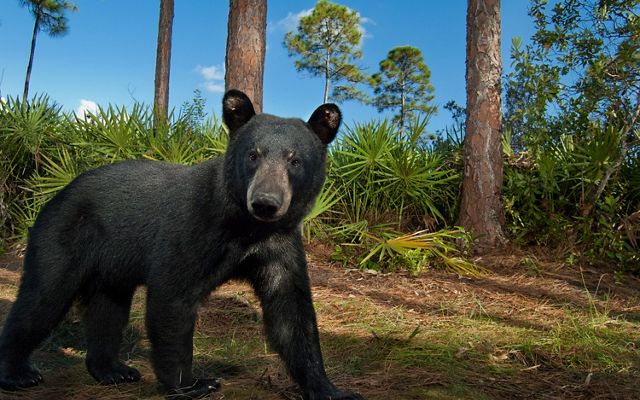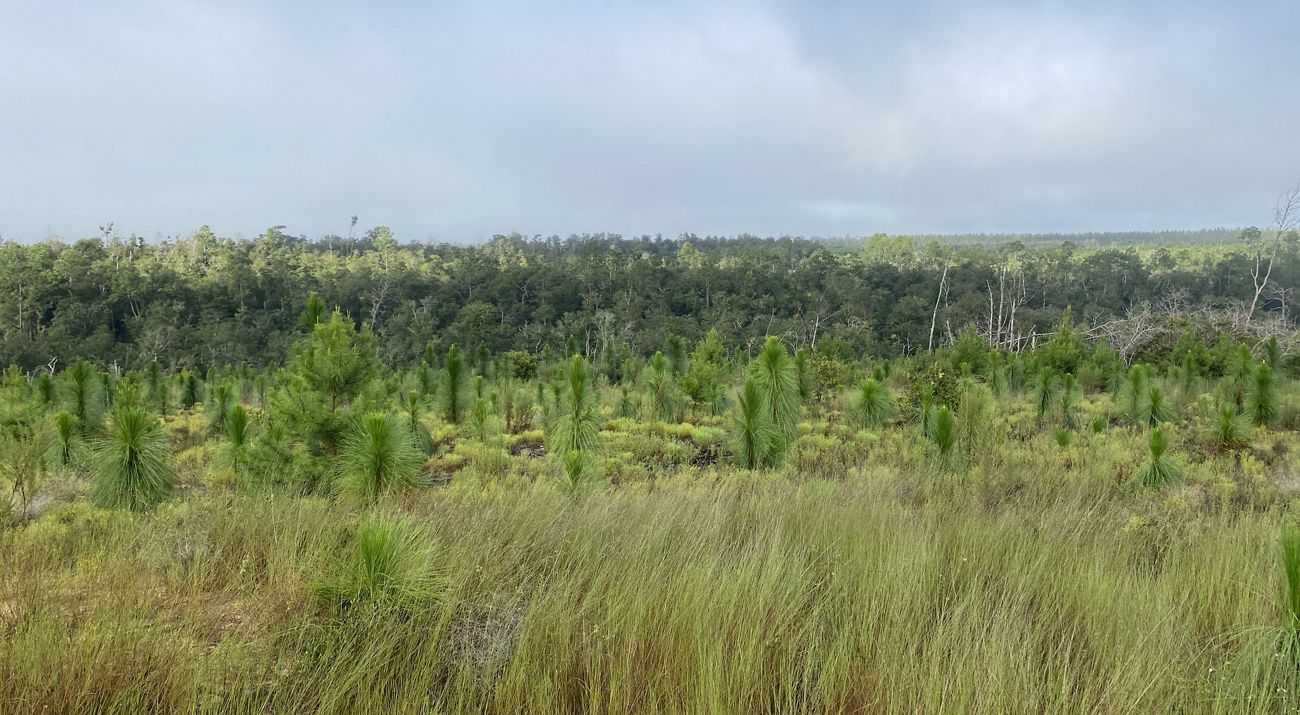The Nature Conservancy & Partners Protect 758 Acres Essential to the Florida Wildlife Corridor Near the Apalachicola River
The land includes the last unprotected part of Sweetwater Creek.
Media Contacts
-
Fran Perchick
Phone: 561-328-9221 x205
Email: fran.perchick@tnc.org -
Carson Mitchell Pena
Phone: 352-318-2945
Email: carson.pena@tnc.org
The Nature Conservancy (TNC) in Florida and its partners announce the purchase and protection of the Cola River Land & Timber property, approximately 758 acres. This property joins a 22,000-acre conservation hub along the upper portion of the Apalachicola River. The Cola River property includes the last remaining unprotected piece of Sweetwater Creek, a major tributary to the Apalachicola River.
This newly protected property connects TNC’s Apalachicola Bluffs and Ravines Preserve (ABRP) with the adjacent Torreya State Park, creating a continuous corridor that supports healthy habitats and safe pathways for wildlife. ABRP, a TNC Center for Conservation Initiatives campus preserve, is a leader in conservation and land stewardship and collaborates with state agencies on management activities.
Quote: Greg Knecht
The protection of the Cola River property is a triumph in collaboration.
“The protection of the Cola River property is a triumph in collaboration,” said Greg Knecht, executive director, The Nature Conservancy in Florida. “The Cola River property was threatened by development, but funders and partners knew we couldn’t afford to lose this property and the wildlife it protects. This achievement highlights the importance of continued collaboration with state agencies, non-profit organizations, private funders and the community to protect another precious piece of the Apalachicola River Florida Forever project. Together, we are working to conserve Florida’s invaluable natural resources now and for future generations.”
The acquisition and protection of the Cola River property were made possible through a partnership with the Florida Department of Environmental Protection (FDEP), utilizing Florida Forever (FF) funds for the state's purchase of the land from TNC as an addition to Torreya State Park. TNC purchased the Cola property with TNC donor funds and private foundation funds from the EJK Foundation, Felburn Foundation and Jelks Family Foundation, Knobloch Family Foundation and Spurlino Foundation.


Connecting the Cola River property with other conserved lands is important for wildlife, collaborative land management and the continued restoration of the historic range of longleaf pine habitats.
For wildlife, the protection of the Cola River property is particularly crucial for species that require large, interconnected territories. As a part of the 18 million-acre Florida Wildlife Corridor, the Cola River property helps connect travel pathways for wildlife. Animals like black bears, Eastern indigo snakes and gopher tortoises can use this piece of the corridor to travel within the Apalachicola River watershed to the 630,000-acre Apalachicola National Forest and other protected areas of the “Forgotten Coast.”
The addition of the Cola River property into the existing network of protected lands also streamlines management efforts between TNC and Torreya State Park, especially in managing sensitive sandhill habitat. TNC’s Center for Conservation Initiatives currently works in partnership with state park staff to manage this habitat at both properties, conducting prescribed burns and controlling invasive species together. The partnership will continue and expand with the addition of the Cola River property, which closes a 758-acre gap between the two properties.
The protection of the Cola River property also opens new opportunities to restore critical ecosystems like longleaf pine forests. Following the devastation wrought by Hurricane Michael, which downed significant timber, the landowner began restoring the property by planting longleaf pine, a project that can now be expanded. Healthy longleaf pine forests are a key piece in efforts to restore critical habitats for the many rare, endangered and threatened wildlife species that call this area home. The property’s unique steep, sloping ravines can support the rare Florida Torreya tree, which only grows in this part of the world.
Sandhill ecosystems require periodic fire to ensure a healthy, functional habitat. Fire maintains sandhills’ open, grassy landscapes, allowing native plants to thrive and creating an ideal landscape for wildlife like snakes and tortoises as they move through the habitat. Without regular fire, sandhill shrubs and small trees grow too dense, changing the function of the landscape. When managed through prescribed burns, sandhills can continue to provide habitat for species like gopher tortoises, whose presence and health impact hundreds of other native species.
“At connected properties like TNC’s ABRP, Torreya State Park and the Cola River property, where we burn together in a cooperative manner, restoring ecosystems with prescribed fire is safer and more efficient and effective because the lands can all be burned together at one time,” said David Printiss, Florida Fire Program director and North America fire specialist, The Nature Conservancy.
“Before this area was developed, periodic fire was a near constant—as natural and necessary as rain. TNC in Florida and our partners do our best to mimic that natural fire through prescribed fires. To continue this important management work for years to come, TNC in Florida’s Center for Conservation Initiatives (CCI) gathers, recruits and trains fire professionals from across North America and extends that collaborative stewardship to Florida government agency land managers too. Together, we are restoring Florida’s natural beauty and incredible ecological function.”
The Cola River property is part of the Apalachicola River Florida Forever project. TNC has worked in the greater Apalachicola River watershed since the early 1980s, saving more than 52,000 acres.
Press kit: Photos, map and media assets for press use with this story.
# # #
About The Nature Conservancy
The Nature Conservancy is a global conservation organization dedicated to conserving the lands and waters on which all life depends. Guided by science, we create innovative, on-the-ground solutions to our world's toughest challenges so that nature and people can thrive together. We are tackling climate change; conserving lands, waters and oceans at an unprecedented scale; providing food and water sustainably; and helping make cities more sustainable. Working in 76 countries and territories, 37 by direct conservation impact and 39 through partners, we use a collaborative approach that engages local communities, governments, the private sector and other partners. To learn more, visit www.nature.org or follow @nature_press on Twitter. In Florida, since 1961, with support from our members, we have helped protect more than 1.2 million acres of vulnerable lands and waters across the state. We own and manage more than 52,000 acres in 25 TNC preserves in Florida. nature.org/florida, facebook.com/NatureConservancyFL, twitter.com/nature_florida, instagram.com/natureflorida/.
The Nature Conservancy is a global conservation organization dedicated to conserving the lands and waters on which all life depends. Guided by science, we create innovative, on-the-ground solutions to our world’s toughest challenges so that nature and people can thrive together. We are tackling climate change, conserving lands, waters and oceans at an unprecedented scale, providing food and water sustainably and helping make cities more resilient. The Nature Conservancy is working to make a lasting difference around the world in 81 countries and territories (40 by direct conservation impact and 41 through partners) through a collaborative approach that engages local communities, governments, the private sector, and other partners. To learn more, visit nature.org or follow @nature_press on X.


